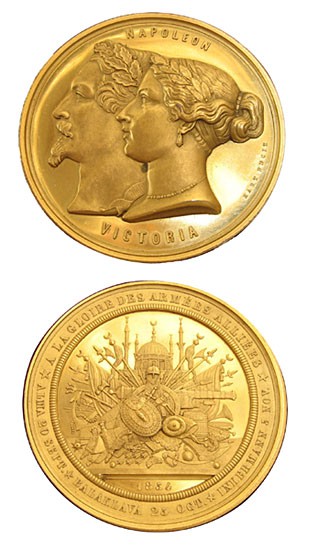The Crimean War, fought between Russia and the Ottoman Empire, saw the Sublime Porte's two principal allies during the conflict – Britain and France – unite in common purpose. It is this alliance, marked by victories achieved at Alma (20 September, 1854), Balaklava (25 October) and Inkermann (5 November) by the Franco-British Expeditionary Corps, that is celebrated in this commemorative medal. Minted in 1854, the medal thus predates the decisive victory at Sevastopol and the allies' official entry into the port, on 12 September, 1855.
But perhaps more important than these shared victories, the medal celebrates above all the new union that now existed between these once bitter enemies. Symbolising the sincere friendship that united the two sovereigns, the obverse features the right-facing effigies of Emperor Napoleon III and Queen Victoria, crowned with laurel wreaths and depicted in profile. This friendship was strengthened by Napoleon III's first state visit to Britain in 1855, a gesture that was returned by Victoria later that year on the occasion of the Universal Exhibition in Paris.
Inscribed on the medal's reverse are the names and dates of the various victories with, at its centre, a trophy constructed from flags and oriental weapons, depicted in front of a mosque. The dedication A la gloire des armées alliées (In honour of the allied armies) surmounts the image. Laurent Joseph Hart (1810-1860), the Belgian engraver who produced this medal, also designed a second model in 1854 which celebrated a similar theme: La France et l'Angleterre unies pour la défense du Droit dans la Guerre de Crimée (France and England united in the defence of Justice in the Crimean War). He had previously made his name with a number of commemorative medals relating to the history of Belgium and the reign of Leopold I. Most notable amongst these was his medal celebrating the laying of the first stone – on 25 September, 1850 – of the monument erected in honour of the Belgian National Congress and the constitution, which at the time was the largest medal ever minted.
A number of bronze and silver medals minted to commemorate the Crimean War exist,(1) but this particular example, made from gold, is exceptional. The medal comes to us via Jean Julien Sacaley (1800-1875), who was the right-hand man to Jean-François Mocquard, chief of staff to the Prince-President (and indeed emperor). Sacaley went on to become first attaché – a natural progression – after which, from 1864, he served as the emperor's deputy chief of staff. He remained a loyal and close associate to Napoleon III until the fall of the empire. The medal was handed down through the family, and it currently sits on display at the Musée du Cabinet des Médailles et Antiques, at the Bibliothèque nationale de France. The circumstances in which it was minted are still to be fully explored, whilst the hypothesis that a second example, also in gold, was once in the possession of Queen Victoria remains to be verified.
Karine Huguenaud (tr. H.D.W.)
We should like to thank M. Daniel Mallet for the information regarding this object.
(1) This should not be confused with the Crimean medal issued by Queen Victoria in 1856 (authorised by imperial decree 26 April, 1856) and awarded to every soldier whose involvement in the war began before 8 September, 1855, the date Sevastopol was captured.
November 2010
Crimean War commemorative medal: "In honour of the allied armies"
Artist(s) : HART Laurent Joseph

- Date :
- 1854
- Technique :
- Gold
- Dimensions :
- Diam. = 7 cm
- Place held :
- Bibliothèque nationale de France, Musée des Monnaies, médailles et antiques, Mallet loan.
- Photo credit :
- © D.R.

